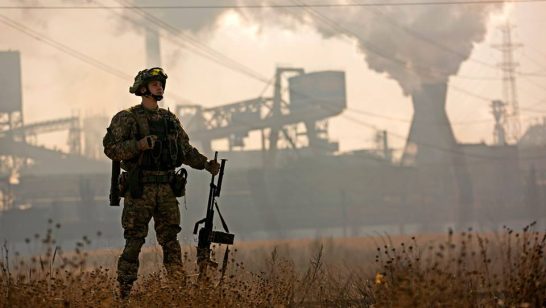
2014 was a tough year for Russia’s economy and ended with a great deal of valid pessimism that 2015 will be worse. GDP will contract this year, having just about managed to avoid a decline in 2014, inflation will continue to rise into the 2nd quarter, bank lending rates will remain around 20 percent and the threat of a full blown financial crisis, i.e. in addition to a growth crisis, is very real.
But while the prevailing mood is almost uniformly negative, there are reasons to be hopeful that the more pessimistic forecasts for the economy can turn out to be wrong. The crisis may yet be the event which economists and private sector business leaders have been waiting for to finally kick-start a more serious reform effort. What happens to sanctions and the oil price will be important but the most important factor will be the decisions taken by the Kremlin and actions actually followed.
Russia’s GDP is expected to have expanded by approximately 0.5 percent last year. The reason it avoided a contraction is because of the positive impact on domestic demand due to the rouble collapse and the block on a lot of imported food. High defence sector spending also contributed to manufacturing sector growth. A decline of about 5 percent over the first two quarters of this year is not an unreasonable expectation as consumer activity and investment spending are expected to collapse. Consumer inflation is expected to peak around 15 or 16 percent in the spring, with food inflation probably near double that, and only when this starts to decline will there be any prospect of a cut in the Central Bank’s 17 percent benchmark rate and even higher bank lending rates.
So the first half of the year is a write-off. What happens in the second half will depend on a number of factors: where oil trades, whether sanctions start to ease, on the inflation and interest rate trend and on the overall mood in the country. A full year contraction of between 3 and 5 percent is most likely, given currently known factors, while the more extreme forecasts should be discarded as the weak rouble protects much of the social payments in the budget and import substitution sustains demand for domestic goods, especially food.
The weak rouble, which fell almost in line with the price of a barrel of oil since late August, has made a big difference in this crisis compared to that of 2009. The rouble fully protected the federal budget revenues in 2014, allowing for a small full year surplus, and while a spending deficit of 2 to 3 percent of GDP is forecast for this year, this is a manageable sum given the available financial reserves. Commentators who are forecasting a much larger deficit are not properly factoring in the impact of the weaker rouble. The fact that the rouble has been allowed to free-float, despite regular interventions to prevent a complete collapse, and uncontrolled crisis with the falling oil price appears to have a short-term political element as well as a positive effect on import substitution. In rouble terms the surplus for 2014 and the more manageable deficit expected in 2015 means that pensions and most public sector salaries can be indexed to protect President Putin’s core support group from the ravages of double digit inflation.
The flip side is that the weak rouble is one of the reasons why inward investment slowed to a trickle in 2014, why capital flight totalled over $150 billion, the highest total since the 1990’s, and why the banks are dangerously short of deposit funding. The state does have the financial resources to provide support for the major banks provided it does so in a timely and efficient manner. That is not to say that Russia may not lose hundreds of banks in this crisis but most of those are so-called pocket-banks and have been on the Central Bank’s radar for years.
The country should have no issues coping with the $105 billion of external debt to be repaid in 2015. Calculations showing that financial reserves may just about cover it neglect to factor in the continuing current account surplus ($57 billion in 2014) or the fact that most of the big corporations who have to pay the bulk of the total earn most of their revenue in dollars and therefore do not need to tap the state for FX.
But while Russia can survive a 12 to 18 month slowdown and can handle funding of external debt and the local banking system (assuming a not much worse oil price and no expansion of existing financial sector sanctions), the real issue is that 2014 events only made a pre-existing condition worse. They did not specifically cause it. The economy had started to slow down from early 2013 as the two previous strong drivers of growth, the consumer and manufacturing, had started to ease back. By late 2013 President Putin, in his annual address to the Federal Assembly, had finally acknowledged that the old model, essentially based on trickle down oil wealth, had been exhausted. The country needed to create a new driver of growth based on a large and sustainable increase in investment. That epiphany came too late as, within weeks, the Ukraine crisis had started.
It means that pulling out of this crisis and growth slump will be a lot slower and harder than was the case for previous crisis. There will be no sharp rebound in growth. Getting back to the annualized growth rate which Russia needs, in the range 4 to 5 percent, will require a big and sustainable increase in spending by both foreign investors and, especially, by Russians. That was always going to be a tough task and the events of the past year and legacy of this crisis will make it much more so. The hope is that the crisis has shaken the complacency and lethargy enough that we will start to see a more effective policy response by the middle of this year. If not, a recession rolling into 2016 and a longer tail of stagnation await.
The opinions articulated above represent the views of the author(s), and do not necessarily reflect the position of the European Leadership Network or any of its members. The ELN’s aim is to encourage debates that will help develop Europe’s capacity to address the pressing foreign, defence, and security challenges of our time.



